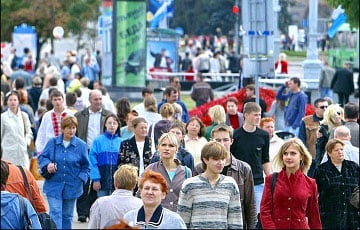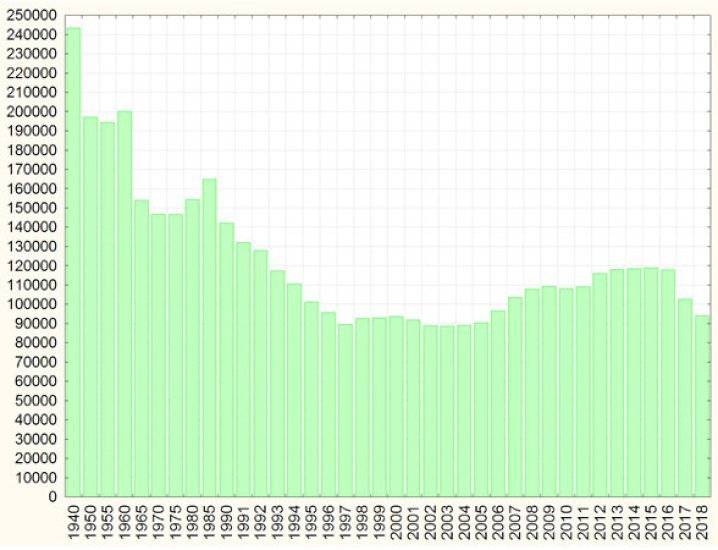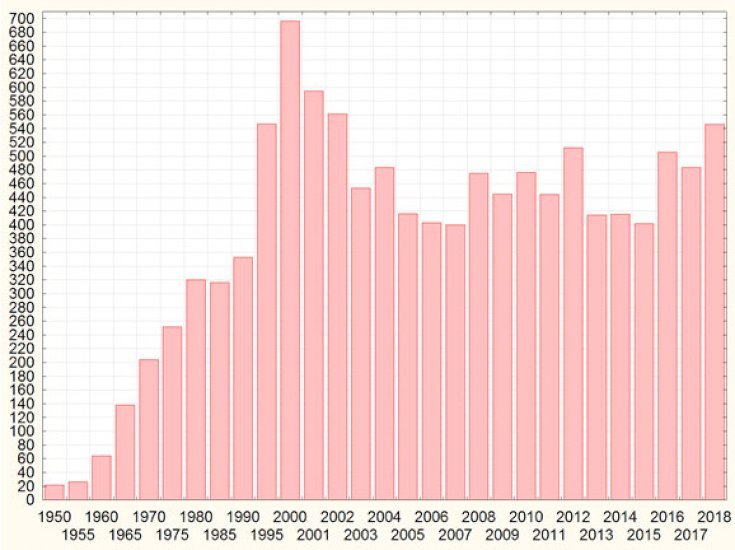Another ‘Record’ of Lukashenka’s Reign
- Aliaksandr Mukha
- 17.10.2019, 15:42
- 5,050

Belarus has registered the minimum birth rate since 1950.
Now Belarus has faced a severe demographic crisis against the background of degradation of traditional family values. In particular, such negative demographic trends as a decline in birth rate, deterioration of marriage and divorce rates, high mortality of men, ageing of the population and so on are observed in the country.
Birth rate decline: children are no longer needed?
According to the National Statistical Committee, 94.042 thousand people were born in Belarus in 2018, which is the minimum indicator for the last 13 years (since 2005).
Unfortunately, another update of this "anti-record" is expected this year. Thus, according to the National Statistical Committee, the number of births in the first half of 2019 decreased by 4.171 thousand people (or 8.9%) to 42.572 thousand compared to the same period last year.
Hypothetically, in 11 years new people in Belarus will stop being born if such a tendency remains.
By the way, if less than 88.5 thousand people are born in Belarus this year, the minimum birth rate will be updated at least for the period from 1950!
To compare: 243.387 thousand people were born in Belarus in 1940, and in 1950 - 197.164, in 1960 - 200.218, in 1985 - 165 034, in 1990 - 142.167, in 2000 - 93.691 and in 2015 - 119.028 (see figure 1).

Demographic crisis in Belarus: a new anti-record
Certainly, the current decline in childbirth in Belarus is to a certain extent connected with the entry of the demographic pit of the 1990s and the first half of the 2000s.
However, the growing average age of a mother is noteworthy. Thus, according to the National Statistical Committee, the average age of a mother at childbirth in 2018 increased to 29.4 years, compared to 25.6 years in 2000 and 25.3 years in 1990.
Thus, now Belarusians postpone the birth of children, choosing the career and life for themselves (including travels, entertainments, etc.).
However, this decision leads to a decrease in the ability to have children, including the ability to have a second child and subsequent children due to objective age restrictions (including diseases of women and men).
By the way, in 2018, 27.1% of pregnant women suffered from urogenital tract infections, 23% - anemia, 6.2% - circulatory system diseases, 4.4% - venous complications, 4.1% - swelling, proteinuria and hypertensive disorders, and 1.5% - diabetes mellitus.
Against this background, 20.8% of newborns fell ill in 2018; 2.6% of them were born with congenital anomalies and 2.2% had birth injuries. At that, 4.4% of the total number of newborns were born before time in 2018.
In general, the total birth rate in Belarus decreased to 1.448 in 2018 against 1.913 in 1990 and 2.764 in 1958-1959.
The total fertility rate is the average number of children that one woman could give birth to throughout the entire reproductive period (15-49 years), while the birth rate at each age remains the same in the year for which the indicator is calculated. Its value does not depend on the age composition of the population and characterizes the average birth rate in a given calendar period.
The total fertility rate above 4.0 is considered to be high, while the total rate below 2.15 is considered low. For reproduction of the population at the current mortality rate, a total fertility rate of at least 2.1 is required. With a lower coefficient, the population of the country begins to decline due to natural reasons.
As a result, given the current total fertility rate in Belarus, we can say that the Belarusian nation is now going extinct.
In this regard, a large number of artificial abortions makes the situation disappointing. Thus, according to the data of the National Statistical Committee, 23.3 thousand abortions were done in 2018 (including abortions with the help of medicines). As a result, there were 249 abortions per 1.000 births in 2018.
To be fair, it is worth noting that the number of abortions is steadily decreasing. To compare: 1.287 abortions per 1.000 births were registered in 2000, 720 in 2005, and 310 in 2010.
Nevertheless, it can be stated that Belarus lost at least 972.9 thousand people because of abortions in 2000-2018. It should be explained that since 2013, the Belstat has started collecting data including medical abortions.
It should be noted that abortions already performed continue to damage the current and expected dynamics of the birth rate in the country due to the deterioration of the reproductive health of women who have undergone an artificial abortion.
Are men's reproductive plans of no interest?
Interestingly, within the current census, the question "Do you plan to have children?" is offered only to women aged 18-49 years.
In our opinion, the decision to deprive men of the opportunity to speak out about their reproductive plans does not seem to be entirely forward-looking for the following reasons.
First of all, however, at the moment men's reproductive behavior still affects the dynamics of fertility, despite the development of modern reproductive technologies that allow women to become pregnant without direct sexual contact.
Second, from an analytical point of view, it is important to compare the reproductive plans of women and men of different age categories. In this case, with the relevant statistical information, it would be possible to learn how much women's reproductive plans coincide with men's ones.
Deterioration of marriage and divorce rates: no more need for families?
At the same time, the number of registered marriages in Belarus is decreasing against the background of birth rate decline. Thus, according to the National Statistical Committee, 60.714 thousand marriages were registered in Belarus in 2018, which is the minimum for the last 14 years (since 2004).
At that, another multi-year minimum of this indicator is expected in the current year. Thus, in the first half of 2019, the number of registered marriages in Belarus decreased by 0.8% to 24.196 in comparison with the same period last year.
Meanwhile, the number of divorces in Belarus remains at a fairly high level. As a result, BusinessForecast.by estimates that 546 divorces per 1.000 marriages occurred in 2018, compared to 696 in 2000, 353 in 1990, 252 in 1975, 64 in 1960 and only 21 (!) in 1950.

According to the National Statistical Committee, as a result of divorce, the number of children without one of the parents amounted to 26.201 thousand in 2018.
Besides, not married women gave birth to 12.206 children or 13% of the total number of children.
The increase in the average age of marriage of Belarusian men and women does not seem to have a positive impact on the reduction of the number of subsequent divorces.
The high death rate of men: men are no longer needed?
The high death rate of Belarusian men (including men of working age) also noteworthy. According to the data of the Belstat, the life expectancy of men (69.2 years) is 10.2 years less than the life expectancy of women (79.4 years).
Moreover, the gap between the rural population of the country looks even wider: men - 65.8 years and women - 77.2 years.
To be fair, it should be noted that in recent years the life expectancy of Belarusian men has been increasing. Nevertheless, in some countries, the life expectancy of men is longer than in Belarus, and the gap between the life expectancy of men and women is lower than in our country.
Thus, according to the Population Division of the UN Department of Economic and Social Affairs, the gap between the life expectancy of men and women is lower than in our country in 2015-2020 in terms of the average life expectancy of men at birth. Belarus ranks 118th in the world.
However, in terms of the average life expectancy of women at birth in 2015-2020 (79.34 years), Belarus ranks 72th in the world.
For comparison, the average life expectancy of men and women at birth in 2015-2020 in some countries and economic territories of the world is presented below.
Hong Kong: men - 81.75 years, women - 87.53 years.
Switzerland: men 81.60 years, women 85.41 years.
Japan: men 81.28 years, women 87.47 years.
Australia: 81.21 years for men and 85.22 years for women.
Italy: men: 81.04 years, women: 85.35 years.
Poland: men: 74.48 years, women: 82.37 years.
Finally, according to the World Health Organization, Belarus ranked 5th in the world by the number of suicides of men in 2016, with a rate of 39.3 suicides per 100.000.
According to the National Statistical Committee, this figure decreased to 33 suicides per 100.000 men in 2018. However, the figure is much higher in the countryside - 65.1 suicides per 100.000 men.
The migration does not compensate for the natural decline in population
Since 2017, the migration growth of the population, unfortunately, no longer compensates for the natural decline of the population (the difference between the number of births and deaths).
Thus, according to the data of the National Statistical Committee, the natural decline in the population of Belarus was minus 26 thousand people in 2018, while the positive balance of migration was at the level of 9.4 thousand people.
This year, the demographic situation has significantly deteriorated. In the first half of 2019, the natural population decline amounted to minus 19.920 thousand people, while the migration growth amounted to only 899 people.
At the same time, against the background of the decline in the birth rate and the increase in life expectancy, the population of Belarus is ageing with all the subsequent negative consequences.
Conclusions
The current demographic crisis in Belarus reflects the ongoing degradation of traditional family values and negative social and economic phenomena.
Therefore, from the point of view of possible enhancement of the demographic situation in Belarus, along with amendments and additions to the current family legislation and other measures of demographic policy, it is advisable to increase the living standards and incomes of the population, together with a decrease in the social stratification in the Belarusian society and a decrease in the level of corruption in the country.
Aliaksandr Mukha, Nashe Mnenie (Our Opinion)










